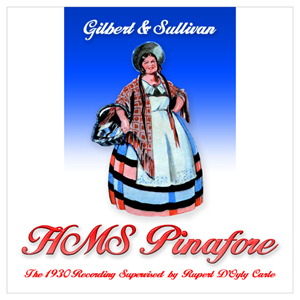The 1930 D'Oyly Carte Pinafore
London Symphony Orchestra
Recorded in London, |
|
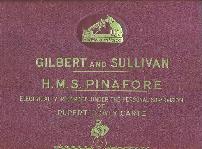 HMV Album No. 100 |
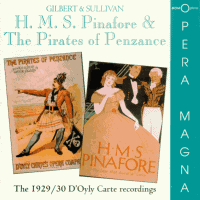 Romophone 89002-2 |
This was the second of seven recordings issued by D'Oyly Carte and HMV over the two-year period from 1930 to 1931. The cast is made up entirely of D'Oyly Carte performers, with the exception of George Baker as the Captain and Stuart Robertson as the Carpenter's Mate. Several are among the greatest all-time exponents of their roles.
Particularly gratifying is Henry Lytton's Sir Joseph. Lytton had a career with D'Oyly Carte that started with the original run of Princess Ida and lasted over half a century, but he only recorded four roles. He is clearly past his prime here, but full of personality nonetheless. Darrell Fancourt's menacing Deadeye should be required listening for anyone who undertakes the role. Granville's Bill Bobstay is also of note, as he played the role in the second Savoy repertory season; he is thus one of the few singers to have recorded a role learned under Gilbert's personal direction. My principal reservation with this recording is the chorus, who are neither in sync with each other, nor with the conductor.
James McCarthy supplied this review of the Conifer (Happy Days) CD re-issue that was coupled with the 1936 Mikado. (Courtesy of International Record Review.)
The value of these recordings lies in the study of performance practice, a window, if you like, into the way these operettas were played in the first part of this century. They are essentially performances by the D'Oyly Carte Opera Company, although not directly advertised as such. Pinafore was recorded in 1930 and The Mikado, in 1936. Much is made by G&S traditionalists of the way these pieces were performed in "the good old days," and the record notes make no bones about this "golden age" of G&S performances. If these performances are any guide, we haven't missed much. Charles Goulding and Elsie Griffin, the Ralph and Josephine retrospectively, sing very badly, with that thin English bleat, so beloved of those to whom any hint of robust singing is in poor taste. Take, for example, "Farewell My Own." The singing borders comparison with Florence Foster Jenkins, and this goes for a very superannuated Henry Lytton. Simply awful. Sargent was musical director for D'Oyly Carte in those days and exhibits none of the style or inspiration which would distinguish him in later years.... The transfers from early electrical 78's are remarkably good, with some distortion showing in the climaxes. The original recordings were supervised by Rupert D'Oyly Carte, and if that is a guarantee of the benchmark set by Gilbert and Sullivan, it is high time the whole G&S "tradition" was re-examined.
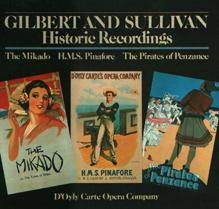 Arabesque 71-6453 |
Jim Farron reported that, in his copy of the set, the liner notes listed the 1922 cast. He assumed that perhaps the distributor had leftover copies of the booklet on its hands and couldn't be bothered to print new ones. Bruce Miller reported, however, that his copy has the same problem, but also includes advertising for sets issued in 1940, or later. Hence, it appears that new sets of notes with the wrong cast continued to be printed. Bruce points out that the side breakdown was the same in both sets, so that part of the notes remained accurate.
This popular set has been frequently re-issued in many formats. It has never—well, hardly ever—been out of the catalog.
Victor's Long-Playing Records
In 1931, Victor introduced a type of long-playing record that allowed all
of H.M.S. Pinafore to fit on just three discs. These records held
between double and triple the amount of music as a standard 78rpm disc.
The 1930 Pinafore was the only D'Oyly Carte recording issued in
this format, although there were non-D'Oyly Carte recordings of
Vocal Gems from Mikado and
Pirates.
However, Victor's long-playing format apparently did not catch on.
Introducing it in the middle of the Depression cannot have helped.
The 1931 Pinafore issue comprised three discs sold separately. The first disc carried "We sail the ocean blue" through "Now give three cheers." The second carried "When I was a lad" through "Things are seldom what they seem." The third carried "The hours creep on apace" through the Act II finale. The 1934 Victor catalog listed these records with slide auto side couplings, although again they were only sold separately.
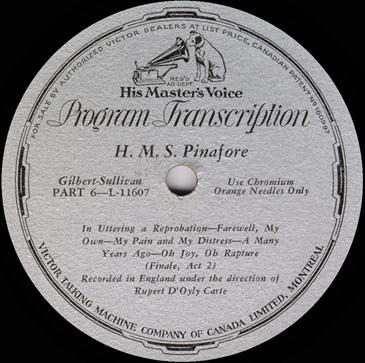 Record Label for one of Victor's early Long-Playing Records. |
The label for one of these records is shown above, kindly supplied by Bruce Miller. Bruce notes that it is a silver label (whereas the original issue on Victor 78's was with Red Seals). Also, it is called a "Program Transcription," which was Victor's name for its new long play "30-minute Records".
[THE GRAMOPHONE, August 1930, (Vol. VIII); pg.130]
THE H.M.V. PINAFORE ALBUM
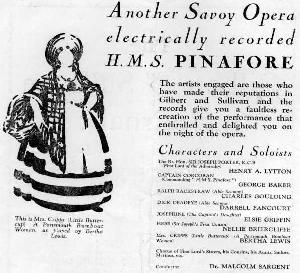 The Gilbert & Sullivan News — September, 1930 |
It should, of course, be H.M.S. Pinafore; we all know that. But in the present instance the above title serves to indicate a version for which "His Master's Voice" is responsible and so to differentiate the gramophonic reproduction from the Savoy original, which has never yet, so far as I am aware, been sanctified by inclusion in the official Navy List. In his Bab Ballads, from which Sir W. S. Gilbert borrowed the idea of the story of the Pinafore (it being his own property), the name of the vessel commanded by Captain Reece was, doubtless for the sake of the rhyme, given as the Mantelpiece; but, once mentioned there, we hear of it no more; whereas immortality, safe almost as that of Nelson's Victory, awaits the name of Captain Corcoran's Pinafore.
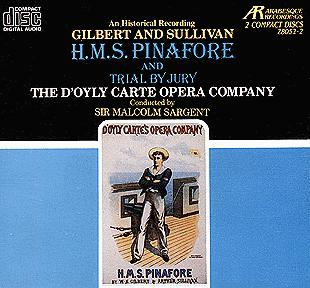 Arabesque Z8052-2 |
It was performed for the first time at the old Opera Comique Theatre, after the withdrawal of The Sorcerer, on May 28th, 1878, and ran for about two years. Its popularity during that period amounted to a "craze." Nothing like it has been known since, either in England or America, where it remains to-day the greatest favourite of all the Gilbert and Sullivan operas, not excluding even The Mikado. Mr Arthur Lawrence has truly said in his Life of Sir Arthur Sullivan, "It was not an uncommon thing for one individual to have seen the piece, say, a dozen times; church choirs added it to their repertoire; thousands of sturdy Puritans, who had never been inside a theatre before, went to see one or other of the performances. It is on record that a hundred thousand barrel-organs were constructed to play nothing else." I wonder how many gramophones will now be sold on purpose to play this Album, which they will not only do a hundred thousand times better, but therewith evoke the most perfect reproduction of the authentic Savoy performance that has yet been achieved.
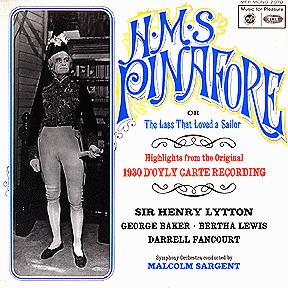 EMI Music for Pleasure MFP 2070 Henry Lytton as Sir Joseph |
There was only one way to arrive at this result, and that was to go to the fountain head for it; which is what H.M.V. has invariably done for its recordings of these operas. In other words, they have placed the entire direction of the business in the able and responsible hands of Mr. Rupert D'Oyly Carte, the son of the famous Richard whom it was my privilege to know from the days when he built the first Savoy Theatre. It goes without saying, therefore, that the present Album offers a complete and faithful replica of the performance recently witnessed at that newly-constructed house. The cast is as follows: Sir Joseph Porter, (Sir) Henry A. Lytton; Captain Corcoran, Mr. George Baker; Ralph Rackstraw, Charles Goulding; Dick Deadeye, Darrell Fancourt; Josephine, Elsie Griffin; Hebe, Nellie Briercliffe; and Little Buttercup, Bertha Lewis. In certain concerted pieces Sydney Granville and Stuart Robertson also take place.
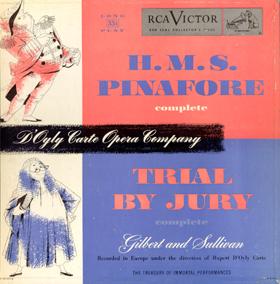 RCA Victor LCT/WCT 6008 |
To state that the whole interpretation of the opera was carried out under the baton of Dr. Malcolm Sargent is to give assurance that the true Savoy traditions have been accurately preserved. His penchant for brisk tempi is no drawback here; rather the contrary, in fact. He maintains the lively atmosphere that the music demands and yet never neglects its delicious sentimental aspects. At one point only do I notice a conspicuous departure from the right Sullivanesque reading, namely, in failing to observe the classic pause before the Captain's "Hardly ever," upon which Sir Arthur absolutely insisted. [See note below.] The work of the chorus and orchestra could not in any way be improved upon; it is simply perfect, and the timbre throughout adapts itself admirably to the exigencies of the recording instrument. The names of the soloists speak for themselves. There is no need to praise either the dry, unctuous humour or the faultless diction of Sir Henry Lytton, who renews in his delightful art all that was so individual and alert in the methods of the famous George Grossmith. Of the others, Miss Bertha Lewis comes nearest in voice and style to Miss Everard or Rosina Brandram; but as Josephine Miss Griffin might perhaps have sung with a trifle more liveliness and spirit.
Herman Klein.
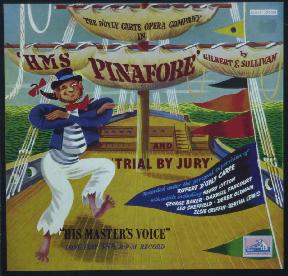 HMV OALP 1293/4. This might just be the most opulent album cover ever to be used for a D'Oyly Carte recording. The cover pictured is the Australian issue. Chris Webster reports that the U.K. issue was similar, except that the HMV logo was pink, and the cover was "unspoilt" by the catalog number. |
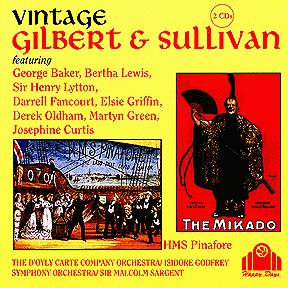 Happy Days CDHD 253/254 |
Note: Concerning Klein's criticism of the interpretation of "I am the Captain of the Pinafore," Bruce Miller writes:
I think Klein's memory is faulty in this observation. He was a friend both of D'Oyly Carte and of Sullivan, and one might expect him to know such details. But Sullivan's autograph of Pinafore, which was used both by the composer and others as a conducting score, shows no such pause. This is the kind of detail which conductors would write in these autographs; numerous examples can be mentioned.
Moreover, it shows Sullivan's alteration of the slurring of the bassoon passage to make it even more connected than it was originally. What Sullivan possibly might have done would be to slow this passage down, and speed it up again on the Captain's "Hardly ever." This would not really be a "pause," but it may be what Klein had in mind. One might expect to see a "rall." or "rit." if it was something Sullivan really wanted, however.
I've never heard it done this way, which is why it caught my attention. I listened to the side, and as Klein mentioned, there is indeed no pause before "Hardly ever" — this is the pause he said Sullivan "always insisted upon" but which I (and probably you as well) have never heard or known about.
However, I think Klein may have gotten that phantom pause confused with the one we always hear in this passage:
I am never known to quail
At the fury of a gale [pause]
And I'm never, never sick at sea.Sargent does, of course, take this pause in both verses. And it is true that while there's nothing in the vocal scores to indicate something happens at this juncture, in Sullivan's autograph there are two conductor's marks (evidently written after the vocal score had been derived from this page) which indicate that Sullivan probably "always insisted on a pause here": a rall. above that spot near the vocal line, and a fermata over the rest higher up in the score, same place.
Review from The Gramophone, 1934
| Date | Label | Format | Number | Comments |
|---|---|---|---|---|
| July 1930 | HMV | 78rpm | D1844-52 in Album 100 | Manual side couplings |
| D7230/8 | Slide auto side couplings | |||
| June 1931 | RCA Victor | 78rpm | 9937/45 in Album C-13 | Manual side couplings |
| 9946/54 in Album AC-13 | Slide auto side couplings | |||
| 1931 | RCA Victor | 12" 2-Sided Long-Playing Records | L-11605/7 | Manual side couplings. See notes below for further discussion |
| ca. 1933-4 | RCA Victor | 12" 2-Sided Long-Playing Records | AL-11679/81 | Slide auto side couplings. See notes below for further discussion |
| 1940? | HMV | 78rpm | D7511/9 | Drop auto side couplings |
| 1940 | RCA Victor | 78rpm | 12927/35 in Album DC-13 | Drop auto side couplings |
| Dec. 1952 | RCA Victor | LP | LCT 6008 | with 1927 Trial |
| 45rpm | WCT 6008 | |||
| 1955 | EMI/ World Records | LP | ALP 1293-4 | |
| HMV (Australia) | LP | OALP 1293/4 | ||
| 1969 | EMI Music for Pleasure | LP | MFP 2070 | Highlights |
| ca. 1981 | Arabesque | LP | 8052-2L | with 1927 Trial |
| Cassette | 9052-2L | |||
| 1982 | Arabesque | LP | 71-6453 | Four discs issued by the Book-of-the-Month Club, with the 1929 Pirates (2 1/2 sides), the 1930 Pinafore (2 1/2 sides) and the 1936 Mikado (3 sides). |
| 1986 | Arabesque | CD | Z8052-2 | with 1927 Trial; Also includes the voice of Sullivan |
| 1990s(?) | Pro Arte | CD | ???????? | One disc; some numbers omitted, including the overture |
| 1994 | Happy Days | CD | CDHD 253/254 | with 1936 Mikado |
| Cassette | MCHD 253/254 | |||
| 1996 | Romophone | CD | 89002-2 | with 1929 Pirates |
| 2000 | 78s 2 CD | CD | GS15 | |
| 2003 | Castle Pulse | CD | PBX CD 468 | With 1929 Pirates |
| 2003 | Sounds on CD | CD | VGS 242 |
| Side Nbr | Matrix Number |
Selection | Rec. Date |
|---|---|---|---|
| 1 | Cc18642-3A | Overture | 5 Feb 30 |
| 2 | Cc18636-5A | We sail the ocean blue | 24 Mar 30 |
| 3 | Cc18639-3 | But tell me, who's the youth | 24 Mar 30 |
| 4 | Cc18637-4A | My gallant crew, good morning | 24 Mar 30 |
| 5 | Cc18704-1 | Sorry her lot / Over the bright blue sea | 14 Mar 30 |
| 6 | Cc18644-2 | Sir Joseph's barge is seen | 6 Feb 30 |
| 7 | Cc18645-1 | When I was a lad | 6 Feb 30 |
| 8 | Cc18641-2A | A British tar is a soaring soul | 14 Mar 30 |
| 9 | Cc18649-2 | Can I survive this overbearing | 6 Feb 30 |
| 10 | Cc18647-3AT1 | This very night with bated breath | 6 Feb 30 |
| 11 | Cc18643-5A | Entr'acte / Fair moon, to thee I sing | 4 Jun 30 |
| 12 | Cc18638-2 | Things are seldom what they seem | 4 Feb 30 |
| 13 | Cc18698-2 | The hours creep on apace | 14 Mar 30 |
| 14 | Cc18713-2A | Never mind the why and wherefore | 24 Mar 30 |
| 15 | Cc18640-3AT1 | Carefully on tiptoe stealing | 4 Feb 30 |
| 16 | Cc18648-2A | In uttering a reprobation | 6 Feb 30 |
| 17 | Cc18646-1A | My pain and my distress | 6 Feb 30 |
| 18 | Cc18705-2 | Oh joy, oh rapture unforeseen | 14 Mar 30 |
Notes:
- For side 10, Francis reports matrix number Cc18647-3A. For side 15, he reports matrix number Cc18640-3AT2. None of my correspondents has reported examples of these numbers, so I have omitted them from the main table.
| Recorded at Kingsway Hall, London (except for the 4 June session, which occurred at Small Queen's Hall, Room C) | |||
|---|---|---|---|
| Side Nbr | Matrix Number |
Selection | Rec. Date |
| Cc18636-1 … |
We sail the ocean blue | 4 Feb 30 | |
| Cc18637-1 … |
My gallant crew, good morning | 4 Feb 30 | |
| 12 | Cc18638-2 | Things are seldom what they seem | 4 Feb 30 |
| Cc18639-1 … |
But tell me, who's the youth | 4 Feb 30 | |
| 15 | Cc18640-3AT1 | Carefully on tiptoe stealing | 4 Feb 30 |
| Cc18641-1 | A British tar is a soaring soul | 4 Feb 30 or 5 Feb 30 | |
| 1 | Cc18642-3A | Overture | 5 Feb 30 |
| Cc18643-1 … |
Entr'acte / Fair moon, to thee I sing | 5 Feb 30 or 6 Feb 30 | |
| 6 | Cc18644-2 | Sir Joseph's barge is seen | 6 Feb 30 |
| 7 | Cc18645-1 | When I was a lad | 6 Feb 30 |
| 17 | Cc18646-1A | My pain and my distress | 6 Feb 30 |
| 10 | Cc18647-3AT1 | This very night with bated breath | 6 Feb 30 |
| 16 | Cc18648-2A | In uttering a reprobation | 6 Feb 30 |
| 9 | Cc18649-2 | Can I survive this overbearing | 6 Feb 30 |
| 8 | Cc18641-2A | A British tar is a soaring soul | 14 Mar 30 |
| 13 | Cc18698-2 | The hours creep on apace | 14 Mar 30 |
| 5 | Cc18704-1 | Sorry her lot / Over the bright blue sea | 14 Mar 30 |
| 18 | Cc18705-2 | Oh joy, oh rapture unforeseen | 14 Mar 30 |
| 2 | … Cc18636-5A |
We sail the ocean blue | 24 Mar 30 |
| 4 | … Cc18637-4A |
My gallant crew, good morning | 24 Mar 30 |
| 3 | … Cc18639-3 |
But tell me, who's the youth | 24 Mar 30 |
| 14 | Cc18713-2A | Never mind the why and wherefore | 24 Mar 30 |
| 11 | … Cc18643-5A |
Entr'acte / Fair moon, to thee I sing | 4 Jun 30 |
Notes:
- The table above shows the published takes in the order recorded. Where a session produced both unpublished and published takes for the same selection, the unpublished matrix numbers are shown in italics. Where none of a selection's takes from a given session were published, the entire row is shown in italics, and the side number is blank. Where it is not possible to make a likely guess about the number of takes recorded at a session, this is indicated with .... Where the published take was achieved without a make-up session being required, the unpublished takes for the same selection are not shown.
- It is likely that there was at one more recording session for s. 11 than the two shown. It was first attempted on either 5 or 6 February. George Baker was present at the 24 March make-up session, and if the Company already knew that none of the February takes was acceptable, surely he would have been asked to re-do it then. It may be that, after a test pressing of the entire set was given to Rupert D'Oyly Carte for his review, he found fault with s. 11 and insisted on a re-take.
